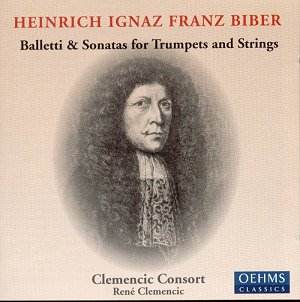Collections of much
of this music have been released with
increasing regularity over the past
decade or so and this serves as a testament
to Biberís exceptional creativity and
versatility. His use of scordatura and
particular timbres are but two examples.
Here René Clemencic and his eponymous
ensemble Ė a string quartet, in effect,
with two trumpets and Clemencic himself
playing harpsichord or organ -give us
a selection which includes the Balleti
a 6 and a number of the Sonatae
tam Aris quam Aulis servientes together
with other smaller works. The ensemble
is an original instrument one and they
make a crisp, clear, not overly sensuous
sound.
The programme has been
selected in such a way that that the
Sonatae break up the longer chamber
pieces. Theyíre played by the two-trumpet
team of Andreas Lackner and Herbert
Walser and as the Sonatae seldom last
longer than a minute and a half this
also acts as a palette cleanser - and
a good contrastive device. The ensemble
proves adept at delineating Biberís
less cerebral Balleti; thereís real
buoyancy in the Sonata opening and a
folkloric insistence in the Amener.
They donít forego the elegance of the
Trazze either, with its sturdy
harpsichord and gruff ending, and the
trumpets have their moment in the Canario
with plenty of headlong attaca. There
are more affectionate, lyric moments
too, as in the Amoresca.
Mensa Sonora, seu
Musica instrumentalis is essentially
Tafelmusik and to that extent more expansive
developmentally than the rather more
musically emblematic Balleti. It was
dedicated to the Archbishop of Salzburg
and is genial, tuneful and entirely
winning. Its expressive peak resides
in the final Sonatina, an Adagio
of richness with an increased array
of tone colours. We also have two parts
of Biberís Harmonia Artificiosa with
their flighty and impressive virtuosity
underscored in this performance. Part
VI is by some way the longer and its
unfolding drama is also reflective of
those Sonatas Ė here we have ebullience
and affect combined with virtuosity
and drama, especially when the solo
violin soars magically and acrobatically
over the bronzed slower middle voicings
The Sonatae tam Aris quam Aulis servientes
Ė Sonata X embodies certain characteristics
familiar from the Mystery Sonatas as
well a penetrating inward expressivity
and it stands as one of the highlights
of the disc.
The sound is unostentatious
and ungimmicky. It captures the ensemble
with fidelity and clarity. If you donít
seek a complete traversal of these works
then this selection is well judged and
very effective.
Jonathan Woolf

![]() Clemencic Consort/René Clemencic
Clemencic Consort/René Clemencic ![]() OEHMS CLASSICS OC 515 [69.28]
OEHMS CLASSICS OC 515 [69.28]






